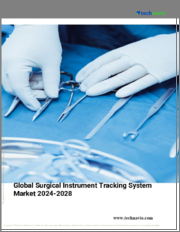
|
시장보고서
상품코드
1520585
수술 기구 추적 시스템 시장 보고서 : 컴포넌트, 기술, 최종사용자, 지역별(2024-2032년)Surgical Instrument Tracking Systems Market Report by Component, Technology (Barcode Tracking, Radio Frequency Identification ), End User, and Region 2024-2032 |
||||||
세계의 수술 기구 추적 시스템 시장 규모는 2023년에 2억 4,230만 달러에 달했습니다. 향후 IMARC Group은 시장이 2032년까지 7억 3,210만 달러에 달하며, 2024-2032년 12.8%의 성장률(CAGR)을 보일 것으로 예측하고 있습니다.
수술기구 추적 시스템은 수술의 다양한 단계에서 재고 관리에 사용되어 의료 전문가의 고유한 요구를 충족시키고 환자 치료의 질을 향상시킵니다. 필요한 기구를 실시간으로 확보할 수 있으므로 사례 지연을 줄이고, 수술의 안전성을 높이고, 복잡한 작업을 단순화하며, 워크플로우를 효율적으로 관리할 수 있습니다. 또한 결함이 있는 기기의 상세한 부하 기록을 생성하고 사용 패턴에 대한 종합적인 인사이트을 제공할 수 있습니다. 그 결과, 수술 툴 추적 시스템은 병원, 개인 클리닉 및 외래수술센터(ASC)에서 수술실(OT)에서 의료 실수를 최소화하고, 직원의 생산성을 높이고, 수술 재고 데이터를 수집하는 데 활용되고 있습니다.
수술 기구 추적 시스템 시장 동향 :
수술기구 취급 실수는 수술 시간과 비용을 증가시키고 수술 감염, 수술 전후 이환율, 수술기구 보유(RSI) 사례의 위험 증가로 이어질 수 있습니다. 이는 수술 인구 증가와 함께 병원내 수술 치료의 안전성을 향상시키기 위한 수술 기구 추적 시스템의 필요성을 높이는 주요 요인 중 하나입니다. 또한 심혈관 질환(CVDs), 관절염, 암, 비만과 같은 만성질환을 앓고 있는 노인 인구 증가는 오염된 기기로 인한 감염을 예방하기 위한 수술 기구 추적 시스템에 대한 수요를 자극하고 있습니다. 이와는 별도로 일부 의료기기 공급업체들은 적절한 중앙 무균 공급부(CSSD) 관리를 위해 최신 스캔 소프트웨어를 통합한 종합적인 수술 기구 추적 시스템을 제공합니다. 또한 2차원(2D) 바코드 및 무선 자동 식별(RFID) 태그와 같은 자동 식별 및 데이터 캡처 기술을 이용한 시스템 개발에도 주력하고 있습니다. 이는 더 나은 환자 관리와 재고 관리에 대한 관심이 높아짐에 따라 시장에 긍정적인 영향을 미치고 있습니다.
이 보고서에서 다룬 주요 질문
- 2023년 세계 수술기구 추적 시스템 시장 규모는?
- 2024-2032년 세계 수술기구 추적 시스템 시장의 예상 성장률은?
- 세계 수술기구 추적 시스템 시장을 촉진하는 주요 요인은 무엇인가?
- COVID-19가 세계 수술기구 추적 시스템 시장에 미친 영향은?
- 세계 수술기구 추적 시스템 시장의 컴포넌트별 시장 분석은?
- 세계 수술기구 추적 시스템 시장의 기술별 시장 현황은? 세계 수술기구 추적 시스템 시장의 최종사용자별 분석은 무엇인가?
- 세계 수술기구 추적 시스템 시장의 주요 지역은?
- 세계 수술기구 추적 시스템 시장의 주요 기업은?
목차
제1장 서문
제2장 조사 범위와 조사 방법
- 조사 목적
- 이해관계자
- 데이터 소스
- 1차 정보
- 2차 정보
- 시장 추정
- 보텀업 접근
- 톱다운 접근
- 조사 방법
제3장 개요
제4장 서론
- 개요
- 주요 업계 동향
제5장 세계의 수술 기구 추적 시스템 시장
- 시장 개요
- 시장 실적
- COVID-19의 영향
- 시장 예측
제6장 시장 내역 : 컴포넌트별
- 하드웨어
- 시장 동향
- 시장 예측
- 소프트웨어
- 시장 동향
- 시장 예측
- 서비스
- 시장 동향
- 시장 예측
제7장 시장 내역 : 기술별
- 바코드 추적
- 시장 동향
- 시장 예측
- 무선 주파수 식별(RFID)
- 시장 동향
- 시장 예측
제8장 시장 내역 : 최종사용자별
- 병원
- 시장 동향
- 시장 예측
- 외래 수술 센터
- 시장 동향
- 시장 예측
- 리서치 센터
- 시장 동향
- 시장 예측
- 기타
- 시장 동향
- 시장 예측
제9장 시장 내역 : 지역별
- 북미
- 미국
- 캐나다
- 아시아태평양
- 중국
- 일본
- 인도
- 한국
- 호주
- 인도네시아
- 기타
- 유럽
- 독일
- 프랑스
- 영국
- 이탈리아
- 스페인
- 러시아
- 기타
- 라틴아메리카
- 브라질
- 멕시코
- 기타
- 중동 및 아프리카
- 시장 동향
- 시장 내역 : 국가별
- 시장 예측
제10장 SWOT 분석
- 개요
- 강점
- 약점
- 기회
- 위협
제11장 밸류체인 분석
제12장 Porter's Five Forces 분석
- 개요
- 바이어의 교섭력
- 공급 기업의 교섭력
- 경쟁의 정도
- 신규 진출업체의 위협
- 대체품의 위협
제13장 가격 분석
제14장 경쟁 구도
- 시장 구조
- 주요 기업
- 주요 기업의 개요
- Becton Dickinson and Company
- Censis Technologies(Fortive)
- Fingerprint Medical Limited
- Getinge AB
- Scanlan International
- Spatrack Medical Limited
- Steelco S.p.A.(Miele)
- Steris
- Ternio Group LLC
- Xerafy Singapore Pte Ltd.
The global surgical instrument tracking systems market size reached US$ 242.3 Million in 2023. Looking forward, IMARC Group expects the market to reach US$ 732.1 Million by 2032, exhibiting a growth rate (CAGR) of 12.8% during 2024-2032.
Surgical instrument tracking systems are used to manage inventory at various stages of surgical procedures to meet the unique needs of healthcare professionals and improve the quality of patient care. They ensure the accessibility of necessary instruments in real-time, which further help reduce case delays, enhance operation safety, simplify complex tasks, and manage workflow efficiently. They can also create detailed load records of defective devices and provide comprehensive insights into usage patterns. As a result, surgical instrument tracking systems are utilized in hospitals, private clinics, and ambulatory surgery centers (ASCs) to minimize medical errors in operation theatres (OTs), enhance staff productivity, and collect surgical inventory data.
Surgical Instrument Tracking Systems Market Trends:
Errors in surgical instrument processing can lead to high operative time and costs and increased risk of surgical infections, perioperative morbidity, and retained surgical item (RSI) cases. This, in confluence with the rising number of individuals undergoing surgical procedures, represents one of the major factors driving the need for surgical instrument tracking systems to improve the safety of surgical care in hospitals. In addition, the growing geriatric population with chronic ailments like cardiovascular diseases (CVDs), arthritis, cancer, and obesity is catalyzing the demand for surgical instrument tracking systems to prevent infections caused by contaminated instruments. Apart from this, several medical equipment suppliers are offering comprehensive surgical instrument tracking systems incorporated with the latest scanning software for proper central sterile supply department (CSSD) management. They are also focusing on developing systems with automatic identification and data capture technologies, such as two-dimensional (2D) barcodes and radio frequency identification (RFID) tags. This, along with the growing emphasis on better patient care and inventory management, is influencing the market positively.
Key Market Segmentation:
IMARC Group provides an analysis of the key trends in each sub-segment of the global surgical instrument tracking systems market report, along with forecasts at the global, regional and country level from 2024-2032. Our report has categorized the market based on component, technology and end user.
Breakup by Component:
Hardware
Software
Services
Breakup by Technology:
Barcode Tracking
Radio Frequency Identification (RFID)
Breakup by End User:
Hospitals
Ambulatory Surgical Centers
Research Centers
Others
Breakup by Region:
North America
United States
Canada
Asia-Pacific
China
Japan
India
South Korea
Australia
Indonesia
Others
Europe
Germany
France
United Kingdom
Italy
Spain
Russia
Others
Latin America
Brazil
Mexico
Others
Middle East and Africa
Competitive Landscape:
The competitive landscape of the industry has also been examined along with the profiles of the key players being Becton Dickinson and Company, Censis Technologies (Fortive), Fingerprint Medical Limited, Getinge AB, Scanlan International, Spatrack Medical Limited, Steelco S.p.A. (Miele), Steris, Ternio Group LLC and Xerafy Singapore Pte Ltd.
Key Questions Answered in This Report
- 1. What was the size of the global surgical instrument tracking systems market in 2023?
- 2. What is the expected growth rate of the global surgical instrument tracking systems market during 2024-2032?
- 3. What are the key factors driving the global surgical instrument tracking systems market?
- 4. What has been the impact of COVID-19 on the global surgical instrument tracking systems market?
- 5. What is the breakup of the global surgical instrument tracking systems market based on the component?
- 6. What is the breakup of the global surgical instrument tracking systems market based on the technology?
- 7. What is the breakup of the global surgical instrument tracking systems market based on the end user?
- 8. What are the key regions in the global surgical instrument tracking systems market?
- 9. Who are the key players/companies in the global surgical instrument tracking systems market?
Table of Contents
1 Preface
2 Scope and Methodology
- 2.1 Objectives of the Study
- 2.2 Stakeholders
- 2.3 Data Sources
- 2.3.1 Primary Sources
- 2.3.2 Secondary Sources
- 2.4 Market Estimation
- 2.4.1 Bottom-Up Approach
- 2.4.2 Top-Down Approach
- 2.5 Forecasting Methodology
3 Executive Summary
4 Introduction
- 4.1 Overview
- 4.2 Key Industry Trends
5 Global Surgical Instrument Tracking Systems Market
- 5.1 Market Overview
- 5.2 Market Performance
- 5.3 Impact of COVID-19
- 5.4 Market Forecast
6 Market Breakup by Component
- 6.1 Hardware
- 6.1.1 Market Trends
- 6.1.2 Market Forecast
- 6.2 Software
- 6.2.1 Market Trends
- 6.2.2 Market Forecast
- 6.3 Services
- 6.3.1 Market Trends
- 6.3.2 Market Forecast
7 Market Breakup by Technology
- 7.1 Barcode Tracking
- 7.1.1 Market Trends
- 7.1.2 Market Forecast
- 7.2 Radio Frequency Identification (RFID)
- 7.2.1 Market Trends
- 7.2.2 Market Forecast
8 Market Breakup by End User
- 8.1 Hospitals
- 8.1.1 Market Trends
- 8.1.2 Market Forecast
- 8.2 Ambulatory Surgical Centers
- 8.2.1 Market Trends
- 8.2.2 Market Forecast
- 8.3 Research Centers
- 8.3.1 Market Trends
- 8.3.2 Market Forecast
- 8.4 Others
- 8.4.1 Market Trends
- 8.4.2 Market Forecast
9 Market Breakup by Region
- 9.1 North America
- 9.1.1 United States
- 9.1.1.1 Market Trends
- 9.1.1.2 Market Forecast
- 9.1.2 Canada
- 9.1.2.1 Market Trends
- 9.1.2.2 Market Forecast
- 9.1.1 United States
- 9.2 Asia-Pacific
- 9.2.1 China
- 9.2.1.1 Market Trends
- 9.2.1.2 Market Forecast
- 9.2.2 Japan
- 9.2.2.1 Market Trends
- 9.2.2.2 Market Forecast
- 9.2.3 India
- 9.2.3.1 Market Trends
- 9.2.3.2 Market Forecast
- 9.2.4 South Korea
- 9.2.4.1 Market Trends
- 9.2.4.2 Market Forecast
- 9.2.5 Australia
- 9.2.5.1 Market Trends
- 9.2.5.2 Market Forecast
- 9.2.6 Indonesia
- 9.2.6.1 Market Trends
- 9.2.6.2 Market Forecast
- 9.2.7 Others
- 9.2.7.1 Market Trends
- 9.2.7.2 Market Forecast
- 9.2.1 China
- 9.3 Europe
- 9.3.1 Germany
- 9.3.1.1 Market Trends
- 9.3.1.2 Market Forecast
- 9.3.2 France
- 9.3.2.1 Market Trends
- 9.3.2.2 Market Forecast
- 9.3.3 United Kingdom
- 9.3.3.1 Market Trends
- 9.3.3.2 Market Forecast
- 9.3.4 Italy
- 9.3.4.1 Market Trends
- 9.3.4.2 Market Forecast
- 9.3.5 Spain
- 9.3.5.1 Market Trends
- 9.3.5.2 Market Forecast
- 9.3.6 Russia
- 9.3.6.1 Market Trends
- 9.3.6.2 Market Forecast
- 9.3.7 Others
- 9.3.7.1 Market Trends
- 9.3.7.2 Market Forecast
- 9.3.1 Germany
- 9.4 Latin America
- 9.4.1 Brazil
- 9.4.1.1 Market Trends
- 9.4.1.2 Market Forecast
- 9.4.2 Mexico
- 9.4.2.1 Market Trends
- 9.4.2.2 Market Forecast
- 9.4.3 Others
- 9.4.3.1 Market Trends
- 9.4.3.2 Market Forecast
- 9.4.1 Brazil
- 9.5 Middle East and Africa
- 9.5.1 Market Trends
- 9.5.2 Market Breakup by Country
- 9.5.3 Market Forecast
10 SWOT Analysis
- 10.1 Overview
- 10.2 Strengths
- 10.3 Weaknesses
- 10.4 Opportunities
- 10.5 Threats
11 Value Chain Analysis
12 Porters Five Forces Analysis
- 12.1 Overview
- 12.2 Bargaining Power of Buyers
- 12.3 Bargaining Power of Suppliers
- 12.4 Degree of Competition
- 12.5 Threat of New Entrants
- 12.6 Threat of Substitutes
13 Price Analysis
14 Competitive Landscape
- 14.1 Market Structure
- 14.2 Key Players
- 14.3 Profiles of Key Players
- 14.3.1 Becton Dickinson and Company
- 14.3.1.1 Company Overview
- 14.3.1.2 Product Portfolio
- 14.3.1.3 Financials
- 14.3.1.4 SWOT Analysis
- 14.3.2 Censis Technologies (Fortive)
- 14.3.2.1 Company Overview
- 14.3.2.2 Product Portfolio
- 14.3.3 Fingerprint Medical Limited
- 14.3.3.1 Company Overview
- 14.3.3.2 Product Portfolio
- 14.3.4 Getinge AB
- 14.3.4.1 Company Overview
- 14.3.4.2 Product Portfolio
- 14.3.5 Scanlan International
- 14.3.5.1 Company Overview
- 14.3.5.2 Product Portfolio
- 14.3.6 Spatrack Medical Limited
- 14.3.6.1 Company Overview
- 14.3.6.2 Product Portfolio
- 14.3.7 Steelco S.p.A. (Miele)
- 14.3.7.1 Company Overview
- 14.3.7.2 Product Portfolio
- 14.3.8 Steris
- 14.3.8.1 Company Overview
- 14.3.8.2 Product Portfolio
- 14.3.9 Ternio Group LLC
- 14.3.9.1 Company Overview
- 14.3.9.2 Product Portfolio
- 14.3.10 Xerafy Singapore Pte Ltd.
- 14.3.10.1 Company Overview
- 14.3.10.2 Product Portfolio
- 14.3.1 Becton Dickinson and Company



















